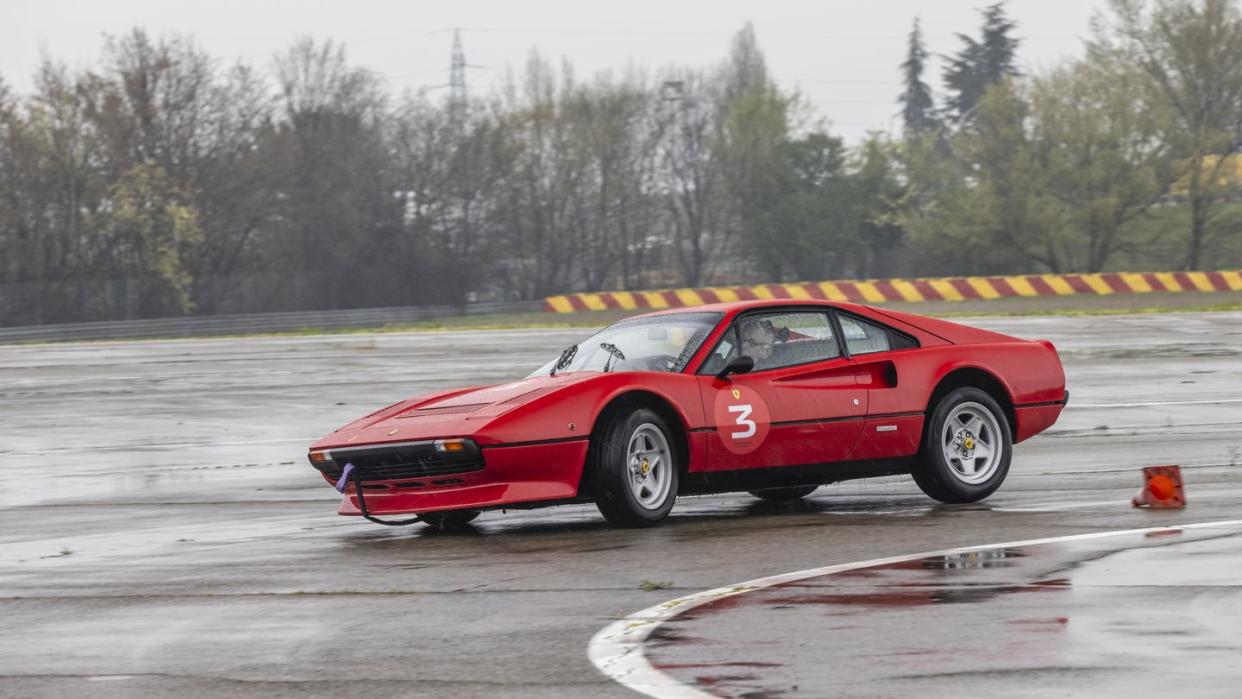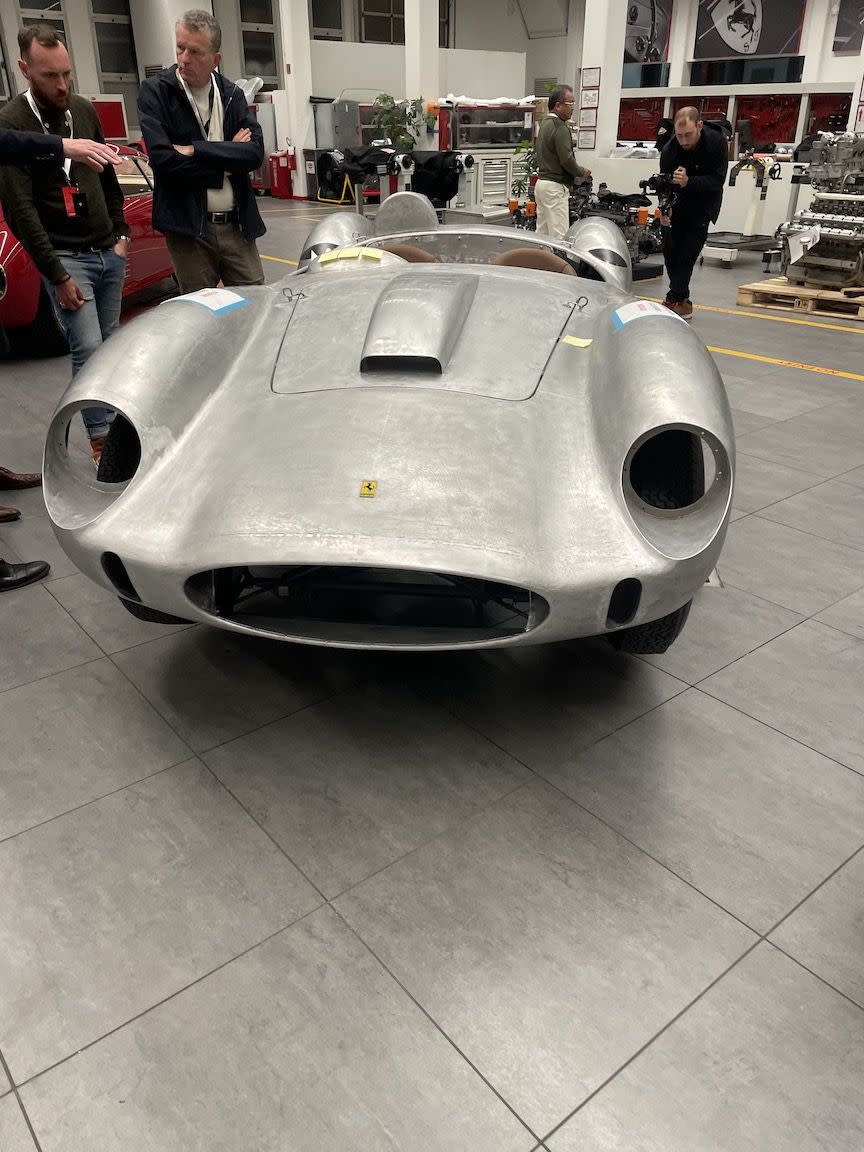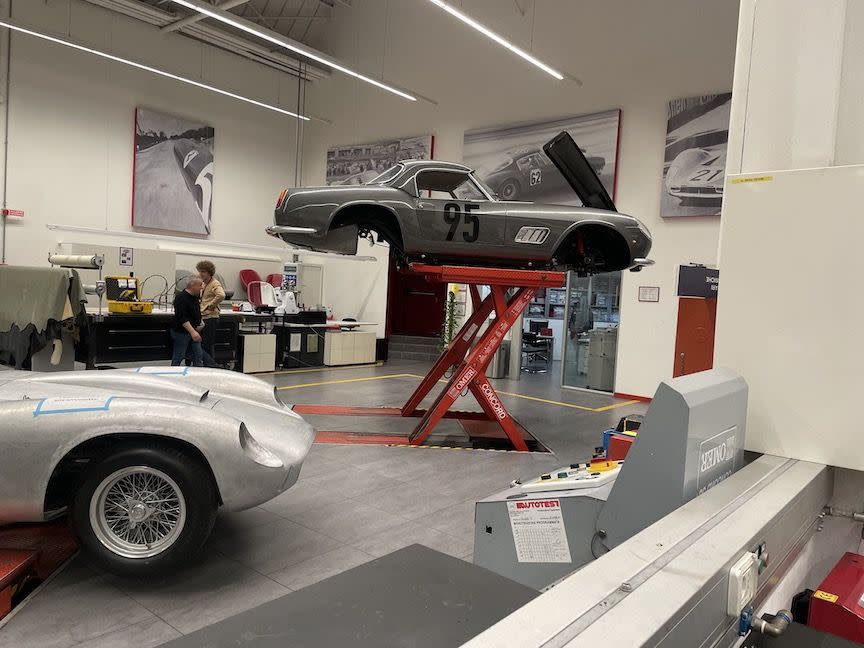Learning to Ride a (Prancing) Horse

"Hearst Magazines and Yahoo may earn commission or revenue on some items through these links."
It's cold, gray, and very wet outside as I speed toward the hairpin at Ferrari's legendary Pista di Fiorano test track, a tricky switchback inspired by Monte Carlo's challenging Gasometer (subsequently La Rascasse) corner. Scant seconds later, with antique wipers vaguely attempting to address the rain pounding the windshield in front of me, I'm braking hard and doing my creaky, old man best to reel in the brutish V-12–powered 1968 Ferrari 365GTB/4 Daytona that I've been invited to drive in a media event celebrating the launch of a new program from Ferrari's Classiche operation, Corso Pilota Classiche.
Available to the regal Italian carmaker's existing customers only, the Corso Pilota Classiche program is an immersive two-day package designed to teach owners of new and vintage Ferraris to better use their valuable machines on the track, focusing on the company's older cars, one assumes with the hope of also increasing sales of modern Ferrari products. As driving schools go, it's hardly the cheapest one might attend. But it's likely the only one that makes a Daytona available to its pupils, along with a 1996 550 Maranello, a 1975 308GTS, a 1980 GTBi, a 1985 3.2 Mondial, and, depending on the day, a 1962 250 Lusso, with a bevy of highly qualified former racing drivers on hand to serve as instructors. These are not the oldest or most valuable Ferraris ever, and it's safe to say F1 pilot Charles Leclerc won't be fine-tuning your heel-and-toe technique, but we can confirm the experience is vastly superior to a poke in the eye with a sharp stick.
Learning on the Test Track
Beyond the arsenal of classic machinery, Corso Pilota Classiche is the only driving instruction program that takes place on the experimental test track that Enzo Ferrari built to vet and fettle the company's racing and road cars. There is great history behind it, which is what the company's Classiche operation, founded in 2006, is all about. Classiche undertakes restoration work near here on Ferrari's longtime premises. Among other mouth-watering treats spied on the day we visited, a 1950s Testa Rossa prototype fitted with the very engine from the car that Alfonso de Portago died in at the 1957 Mille Miglia (a crash rather gruesomely depicted in the recent film Ferrari) in the Classiche workshop for a ground-up restoration.

For a fee, Classiche also certifies cars the company built as correct (or not), utilizing its vast and fastidiously maintained build records to verify specification, original equipment, and any subsequent work done as correct as far as materials and method of construction are concerned, an increasingly important consideration as the value of older Ferraris, especially rare, historic ones, continue their ascent into the stratosphere. Depending on the vehicle in question, costs for this stamp of authenticity range from a few thousand to tens of thousands of dollars; many of its more modern cars are suitable for certification by local Ferrari dealers, while other, rarer, typically older cars will need to be shipped to Maranello for more careful study. Any corrective repairs or part replacements are, of course, extra.
One such car, a very handsome 250 California Spider with a hard top was having a frame outrigger tube replaced, following metallurgical analysis that revealed that the current piece, neatly installed after an accident bent the original, was made from an incorrect alloy. Ah, the cost of keeping it real.

The price of the Corso Pilota program, which may be booked through your Ferrari dealer or via the MyStore section of company's MyFerrari app, also varies, according to Ferrari spokesperson Jeffrey Grossbard, though it begins at several thousand Euros. No exact figure is quoted, Grossbard clarifies, "as it's charged by the dealer that the client works with. This leads to some variability due to local taxes," and should the dealer "decide to package an experience for their client that includes others tours/visits at their discretion." The two-day program fee covers lodging, meals–which included dinners at nearby Ristorante Montana and Ristorante Cavallino during our visit—and a full day driving school at the Fiorano track. Paying customers will get to test their skills with a final day rally competition on the track, as well as take tours of the factory and the Classiche workshops and archive, leaving only airfare as an extra cost.
Opened in 1972 and built with funding believed to have to come from the 1969 sale of a 50 percent interest in the company to Fiat, Ferrari's Pista di Fiorano was sited on two adjoining pieces of farmland Ferrari earlier acquired in Fiorano Modenese, less than a mile from the company's factory in Maranello, a small town about an hour's cab ride from Bologna, where we flew in, or two and a half hours southeast from Milan. A small farm house, from which Il Commendatore once observed proceedings at the purpose built course, on closed circuit television or by looking out his window, sits adjacent to the configurable figure-8 track and has been recently restored. Favored (read: perennial) Ferrari customers can reportedly arrange for an additional charge to stay overnight in the house for that extra-special feeling of oneness with the late maestro and his world, including his old black-and-white TV set.
The 1.9-mile test track was designed to showcase signature corners of differing radii, both right- and left-handed, borrowing inspiration from other famous circuits, including Zandvoort's "Tarzan" corner and the Nürburgring's Brünnchen jump. As a test facility, Corso Fiorano is usefully equipped with the means for wetting its entire surface at will, a facility for which there was no need on the rain-sodden day we hit the track. Similarly, a skidpad within the track's perimeter required no additional watering for an exercise that had students practice getting the 308 sideways and then catching it, a task that proved remarkably tiring for at least one sleep-deprived, barely fit journalist in attendance, exacerbated by the 308's lack of power-assisted steering. Which, to be clear, is not to say it wasn't fun.
Back out on the track, the first corner of the Fiorano course can be configured in two possible ways, both intended to upset a car's balance while braking. Later corners are meant to explore the impact of centrifugal forces on fuel-delivery and lubrication, while giving operators a chance to explore their braking systems in a competition setting. While a drive along with a skilled Italian wheelman showed us how it might be done, our own internal metric told us that the right way to do it was the one where we weren't the guy who stuffed the exquisite Italian metal into the Armco or tire walls. Lessons learned were many, but included a finer understanding of why few bother campaigning He-Man-heavyweight V-12 rear-drive machines anymore. Hard cornering in the Maranello is an all-hands-on-deck exercise, despite the properly balanced distribution of its weight, its intoxicating soundtrack, and undeniable charm. The hard work component is even greater with the Daytona, an even lovelier conveyance that rewards focused input and maximum upper body strength. So while the Mondial still may not look like much when standing next to some of the most beautiful Ferraris the world has ever known, it is an unexpectedly agreeable machine to drive as fast as you can once you've worn yourself out in the Daytona.
Corso Pilota Classiche is an idea whose time has clearly come and undoubtedly will prove a fine money printer for Ferrari. However, with many of today's young owners on the go—millionaires and billionaires born in an era when increasingly few ever learn the disappearing art of stick-shift driving—it seems that one task that this new Classiche program might want to consider adding to its activities list is a day of manual transmission training. For the 26-year-old master of the universe who won the multimillion-dollar 250GT Le Mans at the Gooding auction but still doesn't really know how to make it go, this could be a critically useful service.
Mastering rev matching and double declutching is not the stuff of a brief conversation with an instructor with finite English-language skills. Then again, while some of us can't afford to make mistakes (raises hand), many of Classiche's customers can. And if they do, they'll be in the best place to set things exactly right.
You Might Also Like
